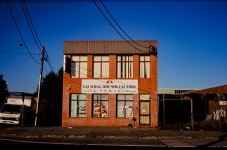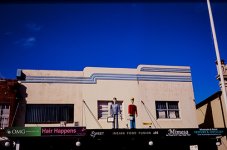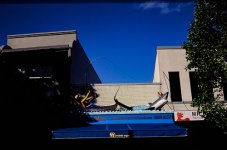bud.petal
Member
Hi all,
I have a problem with some of the photos from my Leitz Minolta CL (M-Rokkor-QF lens). About a third to half of the photos have this strange faint (and sometimes darker) black shadow. It's always in the same spot at the top of the photo and it also shows on the negatives/slides.
Does anyone have any idea what could be causing this?
Thanks,
Eran.
I have a problem with some of the photos from my Leitz Minolta CL (M-Rokkor-QF lens). About a third to half of the photos have this strange faint (and sometimes darker) black shadow. It's always in the same spot at the top of the photo and it also shows on the negatives/slides.
Does anyone have any idea what could be causing this?
Thanks,
Eran.
Attachments
ruby.monkey
Veteran
A touch of front shutter curtain bounce?
Rob-F
Likes Leicas
Did it used to be OK, and this is a new development?
bud.petal
Member
Did it used to be OK, and this is a new development?
It has been doing this since I bought the camera about 6 months ago. But since then I had the camera CLA'd and I shot a test roll (from which these 3 photos are taken) and it is still producing these lines. Could it be the lens maybe?
bud.petal
Member
A touch of front shutter curtain bounce?
I thought that might be it too, so I had the camera CLA'd and after a test roll from which these photos are taken the problem is still there.
DHK
-
Interesting that the flag pole isn’t affected. The shutter on that camera is vertical.
Arbitrarium
Well-known
Got to be shutter bounce or capping surely. I'd send it back to whoever serviced it.
Ko.Fe.
Lenses 35/21 Gears 46/20
Interesting that the flag pole isn’t affected. The shutter on that camera is vertical.
It isn't vertical.
Looks like my M4-2 light leaks. I was told it curtains to be replaced.
css9450
Veteran
It isn't vertical.
Looks like my M4-2 light leaks. I was told it curtains to be replaced.
CL has a vertical-travel shutter.
Looks to be a curtain problem. The flagpole is interesting, but it's a strong highlight. Assume it's overwhelmed the general reduction of exposure in the zone resulting from first curtain bouncing back in.
Can I suggest that all the affected images were made at higher speeds. Yes?
Because the effects of bounce usually last only a few milliseconds, when it occurs at slow to medium speeds the effect relative to the nominal exposure time is negligible. At, say, 1/1000 or to a lesser extent 1/500, as a percentage of the nominal exposure time the additional exposure (if the second curtain is bouncing) or reduction in exposure (if it's the first) become significant enough to matter.
In some scenes, Eg a variety of foliage, the bounce may be happening but the variation in tonalities may make it less obvious or even impossible to spot. On the other hand an evenly illuminated sky is going to betray exposure variations across the frame much more easily.
Hence, if you suspect bounce issues, a series of images of a scene of even tonality and consistent illumination, at shutter speeds from maximum down to 1/125 or so, will usually inform the diagnosis.
Can I suggest that all the affected images were made at higher speeds. Yes?
Because the effects of bounce usually last only a few milliseconds, when it occurs at slow to medium speeds the effect relative to the nominal exposure time is negligible. At, say, 1/1000 or to a lesser extent 1/500, as a percentage of the nominal exposure time the additional exposure (if the second curtain is bouncing) or reduction in exposure (if it's the first) become significant enough to matter.
In some scenes, Eg a variety of foliage, the bounce may be happening but the variation in tonalities may make it less obvious or even impossible to spot. On the other hand an evenly illuminated sky is going to betray exposure variations across the frame much more easily.
Hence, if you suspect bounce issues, a series of images of a scene of even tonality and consistent illumination, at shutter speeds from maximum down to 1/125 or so, will usually inform the diagnosis.
brbo
Well-known
Edit: nevermind, I didn't know that CL has a vertical-travel shutter!
ruby.monkey
Veteran
CL has a vertical-travel shutter.
Better have, or else someone sold me a fake!
Ko.Fe.
Lenses 35/21 Gears 46/20
CL has a vertical-travel shutter.
Strange, this morning I read CLE in OP.
Dan Daniel
Well-known
Strange, this morning I read CLE in OP.
Too much E can do that to you....
Steve M.
Veteran
It's probably your camera's film gate blocking some of the light getting to your film. Take a look and see if the film is riding where it needs to be when you put another roll in the camera and advance it a little to get the film taught. Remember that your camera exposes the image on the film upside down and backwards from how you view it, so the problem w/ the film gate would be at the bottom not the top. Sometimes this happens when the film is not loaded exactly in the center of the take up spool, or it could be just a small misalignment in how the film canister rides in the camera. If you look carefully w/ the film in the camera (you will only lose a few frames on the front of the roll) you should be able to puzzle out what the problem is.
Since you're sending the film out to a lab, the problem could conceivably be on their developing end, so if you ck things out as I mentioned and all looks good, try another lab.
Since you're sending the film out to a lab, the problem could conceivably be on their developing end, so if you ck things out as I mentioned and all looks good, try another lab.
ColSebastianMoran
( IRL Richard Karash )
Maybe a dumb question, but are you sure the defect is in the negative? Or could it be in the scan or print process, not in the negative?
It's probably your camera's film gate blocking some of the light getting to your film. Take a look and see if the film is riding where it needs to be when you put another roll in the camera and advance it a little to get the film taught. Remember that your camera exposes the image on the film upside down and backwards from how you view it, so the problem w/ the film gate would be at the bottom not the top. Sometimes this happens when the film is not loaded exactly in the center of the take up spool, or it could be just a small misalignment in how the film canister rides in the camera. If you look carefully w/ the film in the camera (you will only lose a few frames on the front of the roll) you should be able to puzzle out what the problem is.
Since you're sending the film out to a lab, the problem could conceivably be on their developing end, so if you ck things out as I mentioned and all looks good, try another lab.
Steve that's always a possibility worth bearing in mind, however if this was the problem then one would expect it to be present in all of the frames on a roll, yes? Though depending on the obstruction, I could appreciate how portrait v landscape might give different results, if the obstruction has any flexibility and may move around.
We're still waiting for additional information from the thread starter, but the examples shown all look to be taken in plenty of light, suggesting higher speeds than lower. I'm sure it's caused by the first curtain bouncing. Whether the camera was recently serviced or not the shutter's not spot on. If the curtain spring tension is correct the brake needs attention, otherwise the tension might be too high. Either way it's not manifesting badly so ought to be able to be corrected.
Cheers
Brett
bud.petal
Member
Got to be shutter bounce or capping surely. I'd send it back to whoever serviced it.
I think I might have to send it back. Though I was hoping there might be a quick fix to this or it was something I did wrong.
bud.petal
Member
Looks to be a curtain problem. The flagpole is interesting, but it's a strong highlight. Assume it's overwhelmed the general reduction of exposure in the zone resulting from first curtain bouncing back in.
Can I suggest that all the affected images were made at higher speeds. Yes?
Because the effects of bounce usually last only a few milliseconds, when it occurs at slow to medium speeds the effect relative to the nominal exposure time is negligible. At, say, 1/1000 or to a lesser extent 1/500, as a percentage of the nominal exposure time the additional exposure (if the second curtain is bouncing) or reduction in exposure (if it's the first) become significant enough to matter.
In some scenes, Eg a variety of foliage, the bounce may be happening but the variation in tonalities may make it less obvious or even impossible to spot. On the other hand an evenly illuminated sky is going to betray exposure variations across the frame much more easily.
Hence, if you suspect bounce issues, a series of images of a scene of even tonality and consistent illumination, at shutter speeds from maximum down to 1/125 or so, will usually inform the diagnosis.
Thanks for that. Most of the photos I took on this roll were shot on 1/125 or slower, usually on f16. It's hard to tell by looking at all the photos on this roll whether the shutter speed had anything to do with it. I didn't shoot any photos on this roll with faster than 1/125 speed.
You can only notice the black shadow line on light backgrounds like a blue sky.
bud.petal
Member
It's probably your camera's film gate blocking some of the light getting to your film. Take a look and see if the film is riding where it needs to be when you put another roll in the camera and advance it a little to get the film taught. Remember that your camera exposes the image on the film upside down and backwards from how you view it, so the problem w/ the film gate would be at the bottom not the top. Sometimes this happens when the film is not loaded exactly in the center of the take up spool, or it could be just a small misalignment in how the film canister rides in the camera. If you look carefully w/ the film in the camera (you will only lose a few frames on the front of the roll) you should be able to puzzle out what the problem is.
Since you're sending the film out to a lab, the problem could conceivably be on their developing end, so if you ck things out as I mentioned and all looks good, try another lab.
Thanks for that. That makes sense. I'll definitely check what you suggested!
Share:
-
This site uses cookies to help personalise content, tailor your experience and to keep you logged in if you register.
By continuing to use this site, you are consenting to our use of cookies.



